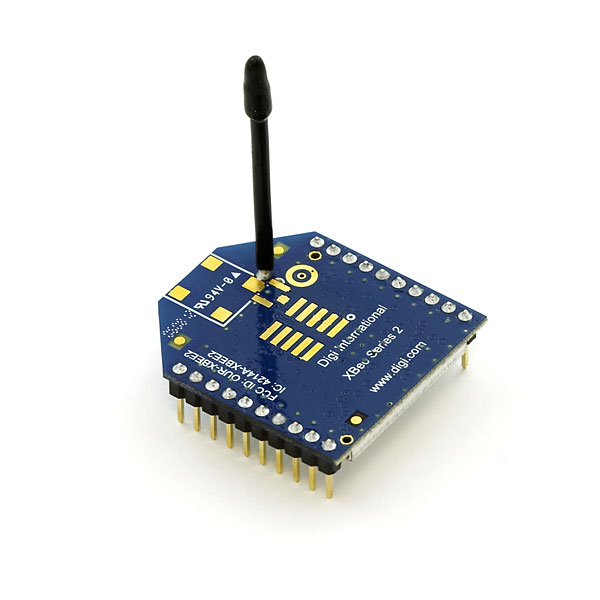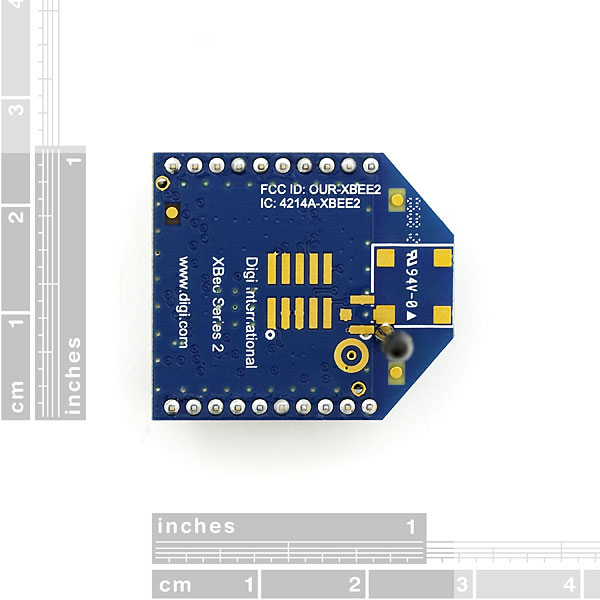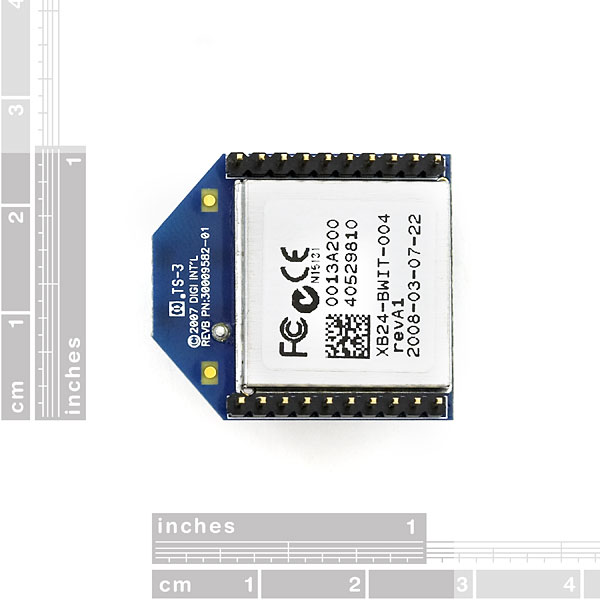XBee 2mW Series 2.5 Wire Antenna
Replacement:WRL-10414. This new version is a Series 2 which uses a much newer firmware. It is compatible with the Series 2.5, if you upgrade the firmware through X-CTU.
This is the new 2.4GHz XBee XB24-BWIT-004 module from Digi (formally Maxstream). Series 2.5 improves on the power output and data protocol. These modules take the 802.15.4 stack (the basis for Zigbee) and wrap it into a simple to use serial command set. These modules allow a very reliable and simple communication between microcontrollers, computers, systems, really anything with a serial port! Point to point and multi-point networks are supported.
Please Note: Series 1 and Series 2.5 XBee modules have the same pin-out. However, Series 1 modules cannot communicate with new Series 2.5 modules.
- 3.3V @ 40mA
- 250kbps Max data rate
- 2mW output (+3dBm)
- 400ft (120m) range
- Built-in antenna
- Fully FCC certified
- 6 10-bit ADC input pins
- 8 digital IO pins
- 128-bit encryption
- Local or over-air configuration
- AT or API command set
Comments
Looking for answers to technical questions?
We welcome your comments and suggestions below. However, if you are looking for solutions to technical questions please see our Technical Assistance page.
Customer Reviews
No reviews yet.




I grabbed a couple if these thinking they were higher powered and improved series 1 units, I was mistaken. I would like to warn anyone considering them that the 2.5 series modules are Infrastructure mode only. There is no basic point to point on these, it took me hours of head scratching and document skimming to get 2 of them talking.
Unless your application requires a multi-node mesh network, i would suggest getting some series 1 units instead. Sadly the description on these is not helpful at all.
These are fantastic devices. Too bad point-to-point communication is difficult with this version.
If I'd paid more attention to what danvm said above, I might have saved a lot of frustration today. Since I didn't I'll just repeat it: This version of the XBee doesn't just "improve on the data protocol", it's completely different. As I understand it, the original XBees work for simple point-to-point communication straight out of the box, more or less. (You need to set source and destination addresses, but it's easy.) To make two of these talk to each other, you need to flash one with the "coordinator" firmware--which requires the X-CTU program, which is compatible with Windows 2000, XP, 2003 only.
I'll give that a try before sending these back, but I suspect I'd be up and running by now if I'd gotten the old XBees instead.
Update: I flashed one (on windows xp, grumble grumble) with the coordinator firmware (the other came with the latest client firmware) and they're talking to each other as soon as I plug them in. So.. Maybe that rant was a bit premature. :)
I've been running X-CTU on Windows 7 without any issues.
But yeah, I wish there was a non-windows option for programming these units. It's a hassle having to boot up an extra machine for such things.
Series PRO 2 is BAAAAAD news ... do a google on XBEE and "Lost communication" ... the modem connection to the chips is very flakey. I managed to program a few of the two dozen chips I bought, but the rest stubbornly refuse to communicate. Tech Support at DIGI could only recomment downloading a new copy of XTCU and firmware ... which did not solve the problem. This is the flakiest development item I have ever worked with ... PICKIT, Arduino,etc. just work when you plug them in. This fails for no stated reason, works occasionally, then fails again.
YOU HAVE BEEN WARNED.
Actually they work quite well for many people.
Perhaps you are having issues with cyclic sleep or some such.
I changed the =sleep timeout to 0xfffe, and that seemed to eliminate a lot of the problems ... perhaps all them. Now I am wondering why XBEE would choose a default value for cyclic sleep timeout that wreaks havoc upon anyone trying to program these things for the first time ....
Thank you for the suggestion about cyclic sleep.
After some additional bad experience ...
I thought the cyclic sleep was the problem, so I reprogrammed all 20 modules to lengthen out the sleep time ... and that seemed to fix it. But, the next day, the modules did not work AGAIN .. a module which had been working happily as an end point started to miss transmissions. I decided to reprogram it as a ROUTER/END POINT to guarantee that it would not sleep. But XCTU would not work,but rather bricked the module, and all the other modules that had been reprogrammed. Maddenly, it "programs" the modules OK, but then on "resetting AT" it "loses communication". This whole system has serious problems .... I've now wasted about 4 days trying to get the "easy" wireless to work .... I would be better off wiring up my own tranceivers using 2n2222's.
hi, i am doing a range test (loop back test) using PIC 18F4550 but the received data is of variable length and incomplete .. can someone please guide me out of this ..
thanks.
Using one of these and a series 2.5 pro module with the large duck antenna, I was able to get almost 500 foot range line of site, before I ran into a fence.<br />
Its neat that these small wire antennas can go that far.<br />
I had one programmed as the coordinator AT and the other programmed as a router AT (latest zigbee firmware) then ran the loop back test using X-CTU.
i want to Atomic IMU module data to send transmit and receive through zig bee protocol.
can i XBee 1mW Chip Antenna sku: WRL-08664 as tansmiter and receive given on sparkfun.com....?
or transmitter and receiver are two different devices use to communicate....?
if two different devices the send me name product name of both tx,rx their data sheet and
prices...?
i am waiting for answer
@itsme_qamar,<br />
Rather then just expecting someone to answer your question why dont you read the data sheet, you would soon realize that this device communicates as a tx and rx therefore you dont need two different devices.